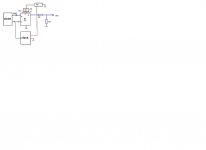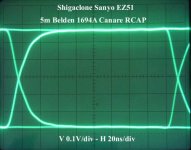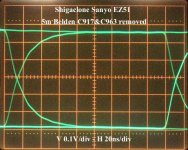Why not this DAC which has a thorough thread on diyaudio also?
High Grade 24bit/192khz DAC with fully assembled kits on eBay (end time 26-Oct-09 17:57:37 GMT)
I'm going to use this DAC, modded and with Lundahl output transformers.
High Grade 24bit/192khz DAC with fully assembled kits on eBay (end time 26-Oct-09 17:57:37 GMT)
I'm going to use this DAC, modded and with Lundahl output transformers.
Why not this DAC which has a thorough thread on diyaudio also?
High Grade 24bit/192khz DAC with fully assembled kits on eBay (end time 26-Oct-09 17:57:37 GMT)
I'm going to use this DAC, modded and with Lundahl output transformers.
Yes, this does look interesting and the transfo is included. I had a look for the thread but could not find it. Can you please post a link?
Why not this DAC which has a thorough thread on diyaudio also?
High Grade 24bit/192khz DAC with fully assembled kits on eBay (end time 26-Oct-09 17:57:37 GMT)
I'm going to use this DAC, modded and with Lundahl output transformers.
I have just ordered the DAC you quoted but in the meantime I think I have found the other thread you mentioned. Here is a extract from one of your comments and I am now confused. As far as I can see, this thread is not about the same DAC as the one you linked to above. Pictures show a single board. Can you clear this up for me? By PM if you want.
Thanks
I have just ordered the DAC you quoted but in the meantime I think I have found the other thread you mentioned. Here is a extract from one of your comments and I am now confused. As far as I can see, this thread is not about the same DAC as the one you linked to above. Pictures show a single board. Can you clear this up for me? By PM if you want.
Thanks
I believe it has the same chip set but also features up-sampling and through hole components rather than surface mount.
Here is a link to a UK forum that discusses your dac. You can still add an output transformer
http://theartofsound.net/forum/showthread.php?t=315
I hope this helps
Richard
Anyone knows if there's a way to reduce rise time in spdif signal at LC78601E pin #29 (dout)?
I'm not sure how about rising time, but one thing you should avoid is the output overload.
BTW here is the nice output reclocking solution that we tried at Polish forum, similar to Peter's CEC output stage.
If you run your clone with an external clock, all you need is fast Flip-Flop and 5V stab, FF output may be terminated with R/R or impulse trafo.
In my view and few fellows who tried, this single tweak implemented even on "fresh" brand new transport brings more than all other mods put together. And costs almost nothing.
Attachments
I believe it has the same chip set but also features up-sampling and through hole components rather than surface mount.
Here is a link to a UK forum that discusses your dac. You can still add an output transformer
CS4397 dac - The Art of Sound Forum
I hope this helps
Richard
Hi Richard, thanks for this link. From what I have seen from the first post on the UK thread, (I havn't read it all yet) this seems to be about the other DAC also or one very similar. The one I ordered is on split boards. It may have the same chip sets, I don't know. I'll see what Havoc has to say. Guess I jumped into this too quickly again.
If I need to do a change-order and they allow it, I'll have to act pretty fast.
Last edited:
Hi Richard, thanks for this link. From what I have seen from the first post on the UK thread, (I havn't read it all yet) this seems to be about the other DAC also or one very similar. The one I ordered is on split boards. It may have the same chip sets, I don't know. I'll see what Havoc has to say. Guess I jumped into this too quickly again.
Its the same dac but the picture in the ebay link also shows the power supply. I purchased one from the same supplier. Be careful when desoldering some of the components as its very easy to lift some of the tracks.
brgds: could you resize a bit, i can't see that sch at all.
Would you have links to the polish forum?
Fran
Here you get better pictures, few recent pages:
Robimy shigaraki transport / CD Flatfish - Do It Yourself - Forum Audio - Audiostereo.pl
I don't know if anyone has ever been able to correlate the "cleanliness" and "squareness"of the dout signal with the listening quality.
For example Steve Nugent (spdif) said that speed-up rise time is a way to better results.
I'm experiencing something interesting about that, but on the contrary to my expectations.
I forgot to try to remove the two ceramic caps C917 & C963 on 8V supply. Many said that their removing improve the sound.
I did and the sound was improved very much indeed.
But the rise time at the end of the digital cable (a 5m Belden 1694A plus Canare RCAP plugs) was 25ns before and 35ns after with a more rounded trace. The supposed "worst" signal sounds better.
I've to say that at the board level the trace are the same, so something changed at the cable level, why? I don't know. I tried different digital cable, but the pattern is the same.
I'll fit a brand new mechanism (I've a couple for spare) next days and I'm very curious too see what was the starting point.
For example Steve Nugent (spdif) said that speed-up rise time is a way to better results.
I'm experiencing something interesting about that, but on the contrary to my expectations.
I forgot to try to remove the two ceramic caps C917 & C963 on 8V supply. Many said that their removing improve the sound.
I did and the sound was improved very much indeed.
But the rise time at the end of the digital cable (a 5m Belden 1694A plus Canare RCAP plugs) was 25ns before and 35ns after with a more rounded trace. The supposed "worst" signal sounds better.
I've to say that at the board level the trace are the same, so something changed at the cable level, why? I don't know. I tried different digital cable, but the pattern is the same.
I'll fit a brand new mechanism (I've a couple for spare) next days and I'm very curious too see what was the starting point.
Attachments
Hi folks.
Having another look at my Shigaclone after having been side-tracked by iTunes/Mac mini/the chinese 24/192 DAC & output transformers (talked about elsewhere on this site).
I want to use a marble base for the Shiga - my question is how difficult is it to drill the necessary holes to anchor the transport in place? I have heard you can use standard masonary drill bits? Unfortunately I don't have a drill press so what are the chances of being able to drill the necessary holes accurately with just a hand drill?
Thanks,
- John
Having another look at my Shigaclone after having been side-tracked by iTunes/Mac mini/the chinese 24/192 DAC & output transformers (talked about elsewhere on this site).
I want to use a marble base for the Shiga - my question is how difficult is it to drill the necessary holes to anchor the transport in place? I have heard you can use standard masonary drill bits? Unfortunately I don't have a drill press so what are the chances of being able to drill the necessary holes accurately with just a hand drill?
Thanks,
- John
Hmm you have to be very careful if you do not have a diamond drill. Marble and granit are more brittle than other types of stone and chip more easily. Go slow with little pressure. I wouldn't do it in hand as that might take forever and not give good results, but that is just me  .
.
Hi folks.
Having another look at my Shigaclone after having been side-tracked by iTunes/Mac mini/the chinese 24/192 DAC & output transformers (talked about elsewhere on this site).
I want to use a marble base for the Shiga - my question is how difficult is it to drill the necessary holes to anchor the transport in place? I have heard you can use standard masonary drill bits? Unfortunately I don't have a drill press so what are the chances of being able to drill the necessary holes accurately with just a hand drill?
Thanks,
- John
Hi John
I used a ceramic drill bit mounted in my drill press, it cut the marble with ease.
Just go slow and apply an even pressure.
Richard
Hi folks.
Having another look at my Shigaclone after having been side-tracked by iTunes/Mac mini/the chinese 24/192 DAC & output transformers (talked about elsewhere on this site).
I want to use a marble base for the Shiga - my question is how difficult is it to drill the necessary holes to anchor the transport in place? I have heard you can use standard masonary drill bits? Unfortunately I don't have a drill press so what are the chances of being able to drill the necessary holes accurately with just a hand drill?
Thanks,
- John
Hi Jonhm,
I'm about to do mine also. First use a new drill bit. The best trick is to use water, have a small fillet run over the hole while you drill. By using water, you will also lengthen the life of your bit.
Good luck and send pictures when you're done
Drill it oversize and then mount the supports to the mechanism. Then sit the whole lot into place in the holes in the marble. Sit the supports into a bed of epoxy resin. That way you get a precisely placed mech and at the same time you can drill the holes a little oversized to allow for errors in drilling.
You will be ok with an ordinary masonary bit, but you must go slow and use plenty of water to cool. Its a good idea to flood the top of the marble so you have a "lake" of coolant.
Fran
You will be ok with an ordinary masonary bit, but you must go slow and use plenty of water to cool. Its a good idea to flood the top of the marble so you have a "lake" of coolant.
Fran
I don't know if anyone has ever been able to correlate the "cleanliness" and "squareness"of the dout signal with the listening quality.
For example Steve Nugent (spdif) said that speed-up rise time is a way to better results.
I'm experiencing something interesting about that, but on the contrary to my expectations.
I forgot to try to remove the two ceramic caps C917 & C963 on 8V supply. Many said that their removing improve the sound.
I did and the sound was improved very much indeed.
But the rise time at the end of the digital cable (a 5m Belden 1694A plus Canare RCAP plugs) was 25ns before and 35ns after with a more rounded trace. The supposed "worst" signal sounds better.
I've to say that at the board level the trace are the same, so something changed at the cable level, why? I don't know. I tried different digital cable, but the pattern is the same.
I'll fit a brand new mechanism (I've a couple for spare) next days and I'm very curious too see what was the starting point.
No one has commented so far, but thanks for sharing the results. It would be interesting to see what has happened to the power supply rails and adjacent grounds since you removed the ceramic caps. I assume there is some inductance present in the trace feeding power to the DSP IC which might account for the reduced slew rate - a clue would be if the supply pins are being modulated by varying current demand in the DSP IC.
My Shigaclone exhibits similarly clean looking spdif signals when properly terminated, and IMO I have not seen too many spdif outputs that were as noise free. A happy accident?
- Home
- Source & Line
- Digital Source
- Finally, an affordable CD Transport: the Shigaclone story


